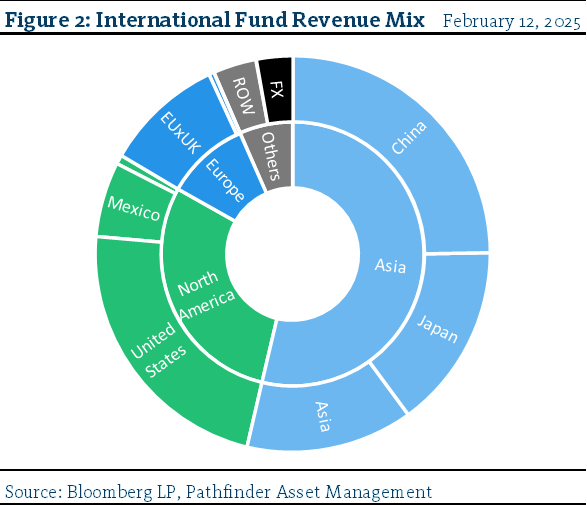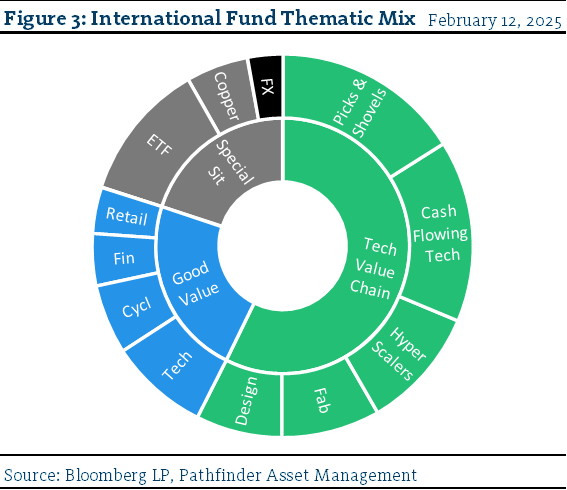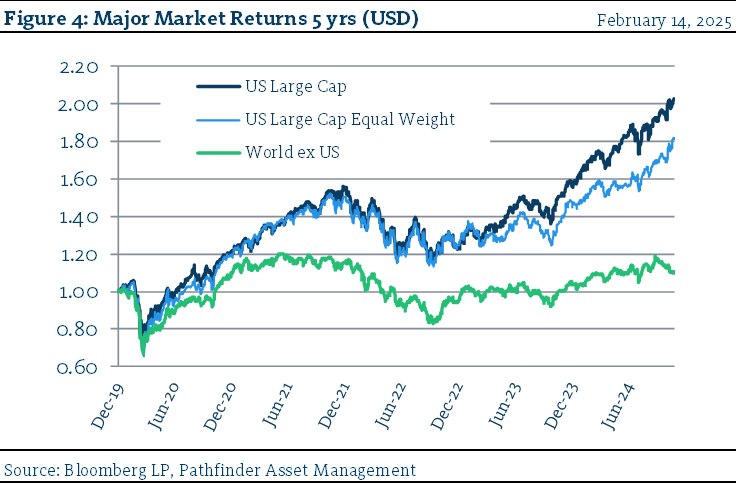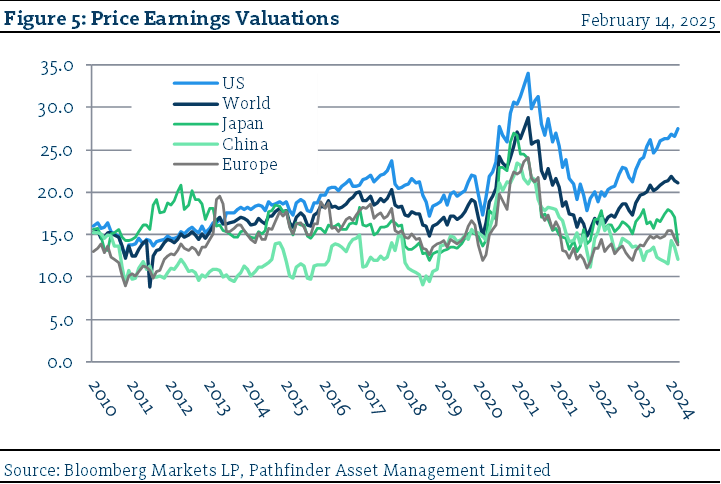International Fund Annual Report
January 2025
We are pleased to present our review and outlook for the Pathfinder International Fund. While the mandate is a stand-alone fund, it is meant to be used in conjunction with the other Pathfinder mandates, along with advice from the Pathfinder Investment Counselling Team here. Please follow this link here to access the Pathfinder archives where we have saved the reviews from other mandates for this and prior years.
PATHFINDER INTERNATIONAL FUND
For the year, the Pathfinder International Fund returned 19.9% while International Developed & Emerging Large & Mid-Cap stocks were up 15.4% (both in CAD terms).

This year, international markets were strong again. However, the US was (also again) much stronger than non-US markets. A combination of poor economic conditions and geopolitical issues caused global investors to focus on the big US companies and, in particular, technology stocks. The main reason for the fund’s performance relative to “the market” was again its exposure to technology, which was a huge positive. We also had a short on the Chinese market that was, in the end, a negative. We have owned Chinese stocks for some time and had placed a short on the market that benefited the fund for most of 2024. However, a quick rally in Chinese stocks at the end of the year surprised us and we did not cover the short quick enough. We have not materially changed our themes that we identified in 2019 and still focus on technology (hardware, ecommerce, industrial electrification & automation), banking and retail in Asia, along with a few special situation commodity companies. Our process is to identify the emerging themes and geographic areas that will benefit from medium to long-term structural trends. Then we add the companies that we believe are the best positioned globally to exploit those opportunities.
FUND POSITIONING AND OUTLOOK
Our best performers for the year were Nvidia Corp. (NVDA US) +195.5%, Xiaomi Corp. (1810 HK) +142.3%, Taiwan Semiconductor (TSM US) +106.9%, Meituan (3690 HK) +102.9%, Nec Corp. (6701 JP) +60.1% and Tencent (700 HK) +55.6%. These were some great returns for some of the largest positions in the fund. While NVDA remains top again for the second year, the Chinese stocks were a huge surprise. Tencent and Meituan were in the “worst performers list” last year but reversed this year. Even after this rebound, China is still one of the few areas where we see true value. For the worst performers, our iShares China (MCHI US) -4.5% (short) was the largest negative contributor (impacting total fund return by -2.5%) because of the position size. While the security ended down (i.e. positive for a short), our trading was poor due to bad timing and volatile price changes in China. Thus, it ended up causing us a loss. With respect to individual long positions, Kingdee Intl Software (268 HK) -17.9%, Valqua Ltd. (7995 JT) -23.1%, iShares MSCI Mexico (EWW US) -24.8%, and Prologis Mexico (FIBRAPL 14 MF) -35.1% rounded out the bottom (all returns above are in CAD and do not include dividends).
Figure 2 presents the funds geographic exposure, based on the individual securities that are in the portfolio. This data is not based on where the company’s shares trade (i.e. NYSE, TSE, LSE, etc.) but based on where, in our analysis, the company’s revenue or business is exposed to. For Example, one of our largest holdings, Tokyo Electron Ltd. (8035 JP) has its shares listed on the Tokyo Stock Exchange (TSE) but it sells primarily in Asia (China, Korea & Japan) and less so in Europe, so we classify the revenue based on this mix, rather than just 100% Japan. As you can see, more than 50% the fund is invested in Asia, with an equal split between China and Japan and the next largest country is the United States (lots of international business sell into the US). Europe is quite small and this is by design.

Figure 3, on the other hand, presents the same firms separated by our investment themes. From our ongoing research process of companies, their suppliers, competitors and customers, we naturally identify investment themes that can be used to position the mandates. We move up and down the value chain of those themes trying to find additions to the portfolios. As we are value investors, we also find companies that are priced below our view of intrinsic value, so we add those to the portfolios as well. For the past two years, we have had a large investment in the technology value chain. This has helped the fund from a performance perspective. We are always on the lookout for new themes to research and deploy.

We reproduce the two charts Figure 4 and Figure 5 below from our 2024 Large Cap Review and Outlook. The charts demonstrate what we believe is a relatively large disconnect in the current global economy and stock markets. After decades of economic cooperation amongst the major economies of the world, it appears now that geopolitical initiatives are causing the large economies (US, China & Europe) to decouple. With the previous growth in globalization, it has been many years since geography has offered investors much diversification. Now it appears that those differences are coming back again. Figure 3 presents return of major markets from the start of COVID until the end of last year. As you can see, there is a significant difference in performance between the rest of the world and the US (almost 2x, with World ex-US essentially flat over the past 5 years). Figure 7 show valuations for the major economies of the world and, as you can see, Asia and Europe offer substantially better valuation at this point. The data is skewed because of the Mag7 but the difference is still clear.


In terms of fund positioning, we will continue to focus on companies that have revenue exposure to those parts of the world that offer both good valuation and true diversification. Outlined below are those themes:
- Tech value chain: we have managed this value chain for a number of years in various forms across multiple mandates at Pathfinder. We started with large tech companies that were generating significant cash flow but had been ignored because of top line growth concerns. Over time, our holdings were adjusted as the cloud and off-premises applications evolved. It changed again through COVID and also with the recent developments of AI. We believe this theme is a long-term cycle that will continue to evolve and provide many opportunities in the years to come.
- Rational Cash flowers: the bread and butter of our investment process. Identifying companies that have growing cash flow and are priced at a significant discount to our opinion of intrinsic value. We will always be on the lookout for this.
- Emerging Companies: a smaller allocation of the fund. We identify companies in different geographies where we expect to discover future investment themes.
Much like the other mandates at Pathfinder, we will continue to be laser focused on our investment management process and continue the search for new companies that fit our thesis, while at the same time keeping an eye on geopolitical developments and potential risk events.
National Instrument 31-103 requires registered firms to disclose information that a reasonable investor would expect to know, including any material conflicts with the firm or its representatives. Doug Johnson and/or Pathfinder Asset Management Limited are an insider of companies periodically mentioned in this report. Please visit www.paml.ca for full disclosures.
Changes in Leverage. We are increasing the asset ceiling to 2.0 times the market value of equity for Pathfinder International Fund and Pathfinder Conviction Fund to be consistent with Pathfinder Partners’ Fund and Pathfinder Resource Fund
*All returns are time weighted and net of investment management fees. Performance returns from the Pathfinder Partners’ Fund and Pathfinder Real Return Plus Fund are presented based on the masters series of each fund. The Pathfinder Core: Equity Portfolio and the Pathfinder Core: High Income Portfolio are live accounts. These are actual accounts owned by the Pathfinder Chairman (Equity) and client (High Income) which contain no legacy positions, cash flows or other Pathfinder investment mandates or products. Monthly inception dates for each fund and portfolio are as follows: Pathfinder Core: Equity Portfolio (January 2011), Pathfinder Core: High Income Portfolio (October 2012) Pathfinder Real Fund (April 2011), Pathfinder Conviction Fund (April, 2013), and Pathfinder International Fund (November 2014).
Pathfinder Asset Management Limited (PAML) and its affiliates may collectively beneficially own in excess of 10% of one or more classes of the issued and outstanding equity securities mentioned in this newsletter. This publication is intended only to convey information. It is not to be construed as an investment guide or as an offer or solicitation of an offer to buy or sell any of the securities mentioned in it. The author has taken all usual and reasonable precautions to determine that the information contained in this publication has been obtained from sources believed to be reliable and that the procedures used to summarize and analyze such information are based on approved practices and principles in the investment industry. However, the market forces underlying investment value are subject to sudden and dramatic changes and data availability varies from one moment to the next. Consequently, neither the author nor PAML can make any warranty as to the accuracy or completeness of information, analysis or views contained in this publication or their usefulness or suitability in any particular circumstance. You should not undertake any investment or portfolio assessment or other transaction on the basis of this publication, but should first consult your portfolio manager, who can assess all relevant particulars of any proposed investment or transaction. PAML and the author accept no liability of any kind whatsoever or any damages or losses incurred by you as a result of reliance upon or use of this publication.